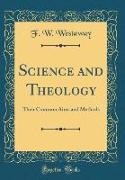Read more
Excerpt from Science and Theology: Their Common Aims and Methods
A second object is to present a picture of the structure and evolution of the universe as conceived in the light of the discoveries of the last forty or fifty years. But it is important to remember that the conception is only a conception. The difference between fact and hypothesis must be carefully discriminated.
A third object is to show that modern science has become a great fundamental factor in human life and progress. Its continuous growth is a proof of its vitality, and its innumerable applications to our daily wants a proof of its ability. No religious system can possibly prevail if it cannot assimilate the great truths of science. The characteristic of the scientific mind is its determination to test every dogma, whatever the authority on which it reposes.
A fourth object is to show that permanent and final truth, Whether in science or in theology, is very rare and very hard to come by and that What we call truth is usually an affair of a greater or less degree of probability. The revelation of truth is conditioned by our ability to receive it. In this world it is always partial and incomplete. Reinterpretation of truths already established are therefore constantly necessary in the light of new knowledge. Most of the divisions amongst Christians may be traced to the fact that men have taken part of the truth as its whole sum and have ceased to look for further knowledge.
About the Publisher
Forgotten Books publishes hundreds of thousands of rare and classic books. Find more at www.forgottenbooks.com
This book is a reproduction of an important historical work. Forgotten Books uses state-of-the-art technology to digitally reconstruct the work, preserving the original format whilst repairing imperfections present in the aged copy. In rare cases, an imperfection in the original, such as a blemish or missing page, may be replicated in our edition. We do, however, repair the vast majority of imperfections successfully; any imperfections that remain are intentionally left to preserve the state of such historical works.

